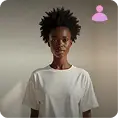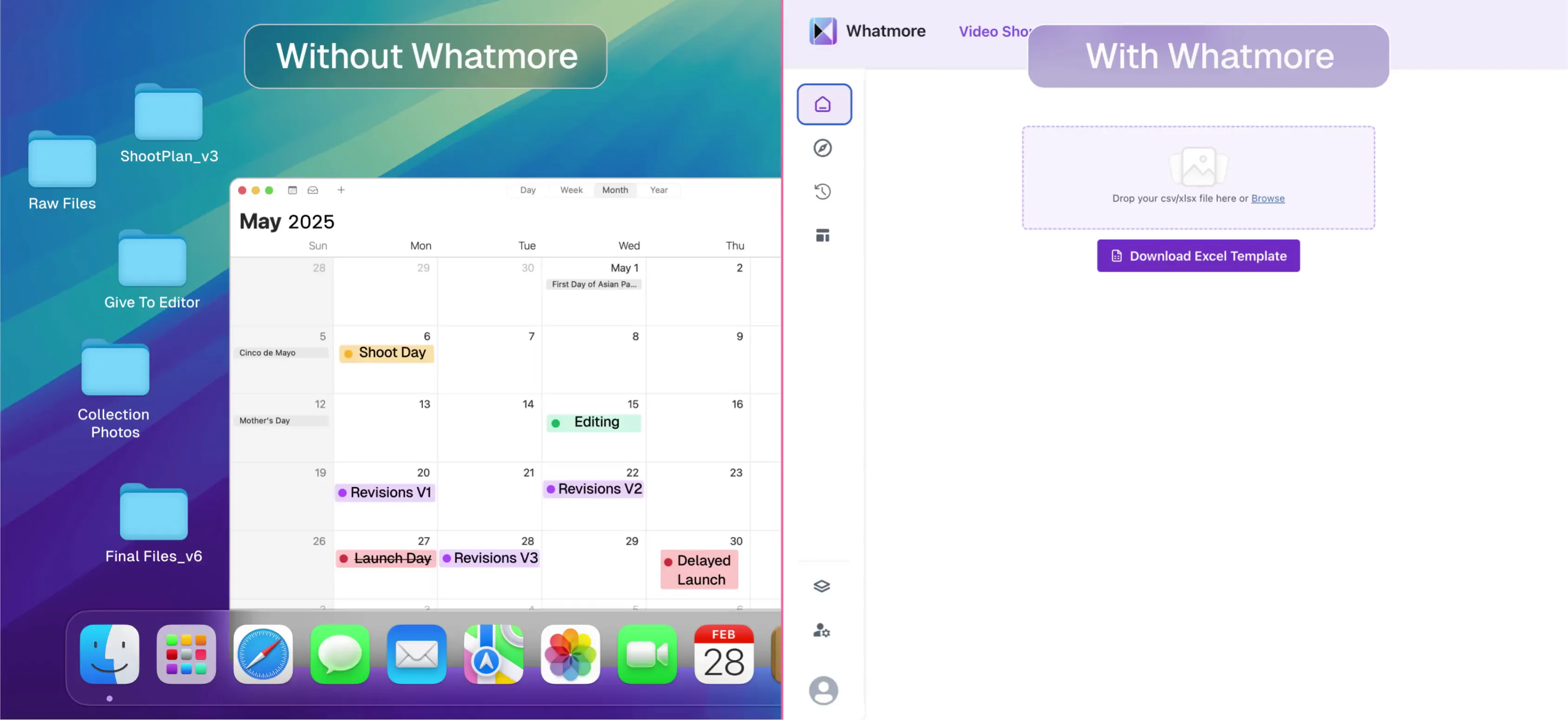







Generate AI model photos, lifestyle backgrounds, and motion videos from Product images! Built for fast moving apparel brands 🔥
*No Credit Card Required
5x Conversion Rate on Website
3x Session Time
25% Lower Bounce Rate










































From catalog ready model shots to ad creatives and lifestyle videos - create all your apparel visuals in minutes. Starting at $2/image!
Automatically pull key product specs from your PDP and stitch them into your videos
Auto-generate shooty-like settings to replace plain backdrops
Turn catalog images into short-form videos with text overlays and music

The Shoot Show Nobody Talks About

Takes weeks to plan

Burns your Budget

Hard to find diversity

Managing logistics is chaos








Close to
Up to
near
near
From product link to studio-quality content. That’s it.

Step 1
Enter your product listing URL. Our Al will gather all the details, images, and Specs from the Page.
Step 2
Pick from lifestyle backdrops, overlays , or Al models. Match your brand vibe without lifting a camera.
Step 3
Preview your AI-generated creatives, tweak backgrounds or formats, and download instantly or save as your Unique Template.
Your next catalog update doesn’t need a shoot, a crew, or a month-long turnaround. With Whatmore, you get studio-quality visuals in minutes and scale across every SKU.

Generate product images from $2/image. No studios, models, or gear required.

Pay $300-$500 per SKU for a full shoot — plus editing and setup fees.

Create PDP, lifestyle, and banner-ready images in minutes for 100+ SKUs.

Wait days or weeks for production teams to deliver each visual asset.

Swap backgrounds, models, or formats instantly — no reshoot needed.

Need an entirely new shoot to test different setups or campaign variations.






High-quality product photography is crucial for ecommerce success in today's digital marketplace. Research shows that 93% of consumers consider visual appearance as the key deciding factor in their purchasing decisions. In the apparel industry, where touch and fit are important but can't be experienced online, exceptional product photography fills this gap.
As we approach 2025, the world of apparel product photography is undergoing a significant change. Traditional photoshoots with physical models and static backgrounds are being replaced by innovative AI-powered solutions. These advanced technologies enable:
The impact on online clothing purchases is remarkable. Brands using these advanced photography solutions report:
As consumer expectations evolve, it becomes essential for brands to showcase their products through high-quality, diverse, and dynamic imagery. This ability will be crucial for brand success.
The future of apparel product photography lies in solutions that combine visual excellence with efficiency, scalability, and technological innovation.
Are you ready to transform your apparel photography strategy for 2025? Let's explore the tools and techniques that will define the next era of visual commerce.
Apparel product photography captures clothing and accessories in their best light to drive sales and engagement. It's the art and science of presenting fashion items through high-quality visual content that showcases:
This specialized photography style combines three key elements:
Modern apparel photography spans multiple formats:
Traditional apparel photography presents significant challenges for brands seeking to maintaina competitive edge in today's fast-paced market. Let's examine the key obstacles:
These challenges create a ripple effect throughout the production pipeline, impacting launch schedules and marketing campaigns. Brands face mounting pressure to deliver diverse, high-quality content while managing tight budgets and accelerated market demands. The traditional approach struggles to meet these evolving needs efficiently.
AI-powered apparel photography is changing the game by offering smart and scalable solutions that go beyond traditional methods.
AI models bring unprecedented diversity to fashion shoots, allowing brands to showcase their clothing on various body types, ages, and ethnicities with a single click. This representation helps customers see themselves in the products, driving stronger connections and higher conversion rates.
The power of AI extends to background customization. Brands can instantly transform plain studio shots into lifestyle settings that align with their aesthetic:
Motion video output capabilities elevate static product images into engaging content. These dynamic visuals capture attention across social media platforms and product pages, delivering:
The face swap feature brings remarkable efficiency to campaign updates. Brands can refresh entire collections by:
This technology eliminates the need for complete reshoots when minor updates are needed. AI-powered solutions cut production time from weeks to hours while maintaining professional quality standards.
AI-powered apparel photography transforms basic product images into dynamic visual content across multiple platforms. Here's how brands leverage this technology:
The versatility of AI-powered photography enables brands to repurpose existing content efficiently. A single product photo can spawn dozens of variations, each tailored to specific marketing channels and customer segments. This technology streamlines the visual content creation process while maintaining brand consistency across all platforms.
Successful AI-powered apparel photography requires careful attention to fundamental elements that enhance the final output. Let's explore the essential components for achieving professional results.
The quality of your input images directly impacts AI transformation results. A well-lit, properly composed photograph provides the AI system with clear data points for generating realistic on-model visuals. Professional lighting creates depth and dimension, allowing the AI to accurately interpret fabric textures and details.
Each lighting setup should match your brand's aesthetic while maintaining consistent illumination across all products. This standardization streamlines the AI processing workflow and ensures cohesive results across your entire catalog.
Strategic positioning transforms basic product shots into compelling visual stories. The right placement techniques enhance AI-powered photography results and create professional-looking content that drives conversions.
These styling techniques work seamlessly with AI photography tools, ensuring consistent results across your product catalog. The combination of thoughtful positioning and minimal props creates professional imagery that scales efficiently while maintaining brand aesthetics.
Remember to test different arrangements with your AI system to identify the most effective positioning patterns for your specific products and brand style.
The art of image editing bridges traditional photography and AI-generated visuals through consistent post-production techniques. A strategic editing process ensures your apparel photography maintains professional quality across all formats.
Professional retouching elevates both traditional and AI-generated apparel images through:
The editing workflow remains consistent whether working with studio photographs or AI-created visuals. Advanced editing software allows for precise adjustments that maintain authenticity while enhancing visual appeal. This standardized approach creates a cohesive look across your product catalog, regardless of the image source.
Modern editing tools integrate seamlessly with AI platforms, enabling batch processing and automated adjustments that speed up production while maintaining quality standards. These tools apply predetermined editing parameters across multiple images, ensuring consistency in your apparel presentation.
The investment in apparel photography varies dramatically based on your chosen approach. Let's break down the costs and benefits of each option:
The DIY approach suits brands starting out, offering control and flexibility. A basic setup paired with AI tools can produce professional-looking results while keeping costs manageable.
Professional studio shoots deliver premium quality and creative direction but require significant investment. These shoots work best for luxury brands or major seasonal campaigns where brand positioning justifies the expense.
Virtual studios bridge the gap between DIY and professional shoots. They eliminate physical space requirements and reduce production costs while maintaining professional standards. This option scales easily with your business needs, making it ideal for growing brands seeking efficiency without compromising quality.
In 2025, high-quality apparel product photography is crucial for successful online retail. The combination of AI technology and traditional photography techniques has transformed how brands display their products, creating immersive online shopping experiences that drive sales.
With the ability to showcase clothing on various models, in different backgrounds, and through captivating motion content, customers can now make confident purchase decisions. This shift in apparel product photography not only saves brands time and resources but also caters to the increasing demands of digital-first consumers.
By adopting innovative solutions like Whatmore Studio, brands can scale their visual content strategy while staying true to their authenticity and quality, both of which are vital for thriving in the competitive e-commerce landscape